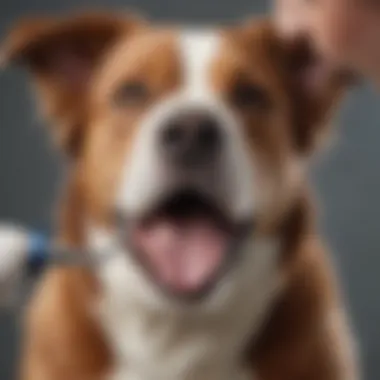What to Do When Your Dog Has Bad Breath: A Comprehensive Guide


Intro
Dog breath is commonly overlooked unless it disturbs pet owners so much that action is taken. Maybe it is just a sign of a good meal, or perhaps something more sinister lies underneath. Understanding the root causes of bad breath in dogs is crucial for maintaining their overall health.
In this comprehensive guide, we will explore potential reasons for your dog’s unpleasant breath. More than just a hygiene issue, bad breath can hint at underlying dental problems or systemic health disorders. For dog owners, improving their pet's oral health goes beyond enhancing companionship; it directly contributes to their long-term well-being. Let's start this journey into identifying and resolving bad breath issues.
Pet Care Essentials
Establishing routine care is essential in regulating a dog's breath. Several factors can enhance or tarnish oral health. Addressing these will improve your dog’s dental condition and consequently their breath.
Daily Nutrition Requirements
Feeding your dog nutritious food has a direct invfluence on their breath. High-quality dog food helps in reducing plaque and bacteria buildup. Brand-specific dog foods such as Hill’s Science Diet or Royal Canin are designed to promote oral health. Includes crunchy kibble for ones that help in cleaning teeth gently during eating.
Hydration is equally crucial. Fresh water can wash away food particles. Lack of it may lead to increased bacteria, worsening those breath issues.
Exercise and Playtime
Regular physical activity can help promote overall well-being. Engaging dogs in play can eliminate stress, which in some cases, leads to behavioral issues related to chewing or eating habits. This, in turn, can reflect on a healthy mouth and fresher breath.
Grooming Tips
Routine grooming is imperative. Regular brushing of your dog’s teeth should be encouraged. Many owners overlook dental care. A suitable toothbrush and dog-specific toothpaste can make all the difference in distinguishing fresh breath. Insert the brushing into routine actions like bathing. Like coat grooming, incorporate dental care into the game.
Health and Wellness Check-ins
Routine vet visits play a significant role in oral health, along with catching potential hidden issues early. A vet can help identify signs like gum disease or decaying teeth. Regular check-ups involve comprehensive health assessments and provide pet owners guidance on maintaining good oral hygiene at home.
Regular dental check-ups can prevent serious health issues that start in your dog’s mouth. If caught early, bad breath issues are easily managed
This publication aims to reinforce the link between effective pet care essentials and managing important signs such as bad breath effectively. Addressing these key components leads to an enhanced quality of life for our canine companions.
Understanding Canine Halitosis
Understanding canine halitosis is essential for all dog owners. It helps to identify the causes and implement strategies for effective treatment. Bad breath in dogs is more than just an olfactory nuisance; it reflects their overall health. Addressing it promotes not only oral hygiene but also informs owners about potential systemic health issues.
Definition of Halitosis in Dogs
Halitosis, commonly known as bad breath, refers to unpleasant odors coming from a dog's mouth. In dogs, this usually indicates a problem that could stem from a variety of health issues. This condition can significantly disrupt the quality of life for both dogs and their owners. Therefore, understanding this term lays the groundwork for recognizing its importance in maintaining the well-being of a pet.
Common Causes of Bad Breath
Several factors contribute to canine halitosis, each presenting its own implications and requiring distinct responses from owners.
Poor Oral Hygiene
Poor oral hygiene is often the most common cause of bad breath. When dental care is neglected, plaque and tartar can buildup on a dog's teeth. This accumulation not only leads to foul odors but also paves the way for more severe dental disease. Maintaining proper dental hygiene combats this issue, and it includes regular brushing and dental check-ups.
Gum Disease
Gum disease is another significant contributor to halitosis. Inflammation or infection can develop in the gums, creating a breeding ground for bacteria that produce bad odor. Periodontal disease can lead to tooth loss and other complications, making awareness of gum health crucial. This cause underscores the importance of dental health in our pets.


Dental Decay
Dental decay is often linked with untreated plaque build-up and too much sugar in the diet. This condition not only brings about bad breath but results in pain for the dog when eating. It's essential to vow for monitoring what your dog consumes and ensuring regular dental care to mitigate this condition. Recognizing dental decay allows pet owners to take preventative measures undoubtedly vital for their furry friends’ health.
Systemic Health Issues
Systemic health issues can also cause bad breath in dogs. Conditions such as diabetes, liver disease, or kidney issues are serious problems. These problems can alter a dog's breath in ways that are not just unpleasant but also indicators of need for professional care. Such health considerations reinforce the idea that bad breath should never be ignored. It reflects broader health aspects that may require veterinary consultation.
Understanding all potential causes gives pet owners a roadmap for effective intervention.
Identifying the Symptoms
Understanding how to identify the symptoms of bad breath in dogs is essential for dog owners. Halitosis, or bad breath, can indicate underlying health issues and oral hygiene problems. Recognizing the symptoms helps in determining the right course of action. Bad breath can often be a precursor to more severe issues such as periodontal disease, dental decay, and oral infections. It is important to observe not only the smell but also the dog’s behavior and overall health. Identifying the symptoms swiftly can lead to timely intervention and can improve the quality of life for your pet.
Characteristic Odors
The primary indicator of halitosis in a dog is an unpleasant odor emanating from the mouth. Characteristic odors can vary, and understanding these can guide pet owners on what steps to take next. For instance, a foul smell might result from decaying food in the mouth, whereas a sour scent often suggests gastrointestinal issues. If you notice a smell that is unlike the usual dog breath, take note as it may reflect a health issue worth exploring further. Knowing the difference in odors can aid in identifying if a vet's visit is necessary.
Accompanying Symptoms
While bad breath, in itself, is a significant concern, other accompanying symptoms are often prevalent and can provide further context to the smell. Assessing these additional symptoms allows for a more comprehensive understanding of the underlying issue.
Excessive Salivation
Excessive salivation can be a warning sign of oral distress or other ailments. This unique feature can relate directly to the bad breath issue, as a dog may overproduce saliva due to dental pain or inflammation. Excessive drool may depict an unfavorable dental condition requiring attention. Dogs that drool excessively might show significant tooth decay or may be suffering an oral infection. Recognizing this trait assists in linking a cause of halitosis to signs of potential pain or discomfort.
Difficulty Eating
Difficulty eating serves as another red flag in diagnosing halitosis reasons. If a normally eager eater is suddenly slow to eat or appears reluctant to consume food, it might denote oral discomfort or pain. This symptom is notable and must not be dismissed lightly. The key character of difficulty eating speaks volumes about the dog’s oral and general health status. If this appears simultaneous to bad breath, it may suggest the presence of dental issues that require prompt veterinary evaluation.
Behavioral Changes
Behavioral changes often accompany bad breath and can signal underlying health issues. Dogs in pain or discomfort may act differently, becoming more withdrawn or irritable. Key characteristics to note include changes in interaction patterns or daily routines. If your playful dog turns lethargic during activities they once enjoyed, investigating possible causes is wise. This behavior suggests other health complications needing to be investigated and serves as a crucial sign post which joins with bad breath.
Always observe your dog’s behavior closely. Noticeable changes might reflect larger issues related to their oral health and overall well-being.
The Role of Dental Care
Dental care is often underestimated in pet ownership. However, maintaining oral health in dogs is crucial for preventing significant health issues, especially bad breath. Good dental hygiene can reduce the bacteria that cause unpleasant odors. Furthermore, an effectively maintained mouth promotes overall health, as one cannot ignore the links between oral and systemic health.
Regular dental care ensures that tartar buildup is minimized. This buildup can lead to gum disease and further health complications. Keeping your pet’s teeth clean is essential in addressing halitosis at its source, rather than just masking the symptoms. When a dog receives proper dental hygiene, you can witness not just improved breath but also a decrease in periodontal diseases.
Importance of Regular Teeth Cleaning
Frequency of teeth cleaning is a vital part of your dog’s dental care routine. Ideally, dogs should have their teeth brushed several times a week, if not daily. Regular oral upkeep helps remove plaque and prevent tartar accumulation. Without vigilant cleaning, dogs can develop severe dental issues, which will undoubtedly lead to bad breath.
In addition, finding the right techniques and routine for cleaning is key. Using a toothbrush specifically designed for dogs is often recommended. A regular cleaning routine reduces reliance on professional cleanings and can translate into savings on veterinary bills in the long run.
Recommended Dental Products
A variety of products exist to help dog owners with dental care. Choosing the right items can have a significant impact on maintaining your dog's oral health.
Toothpaste for Dogs


Toothpaste specially formulated for dogs is essential. Regular human toothpaste can be harmful to dogs. These products contain safe ingredients and come in flavors appealing to dogs, making brushing a favorable experience rather than a chore. Key characteristics of quality dog toothpaste involve the absence of fluoride and other harmful additives. Moreover, toothpastes often include enzymes that specifically target plaque buildup, which contributes directly to bad breath. By integrating dog toothpaste into your home care regimen, it's easier to achieve more effective dental cleanliness.
Dog Toothbrushes
Using appropriate Dog Toothbrushes amplifies the efficiency of dental cleaning. The design usually considers canine anatomy and facilitates access to various angles of a dog's mouth, which is essential to thorough cleaning. It's crucial to choose brushes that are soft to ensure comfort during the brushing process. You might find finger brushes helpful as they provide you with better control in reaching your dog’s back teeth. This careful attention can drastically reduce smell and maintain overall dental health.
Dental Chews
Dental Chews can play an effective role in a comprehensive oral hygiene plan. They are not only tasty but help scrape off plaque as your dog chews. Look for products with the Veterinary Oral Health Council seal, indicating efficacy in controlling dental diseases. This feature gives further assurance that they can help combat bad breath. Incorporating these chews into your weekly routine can ease cleaning duties while keeping your dog engaged and satisfied.
Remember, dog oral health is an investment in your pet’s well-being. By ensuring that appropriate dental products are utilized, you can mitigate issues related to bad breath actively.
Home Remedies for Bad Breath
Addressing bad breath in dogs is essential for both their health and the comfort of those around them. Home remedies play a significant role in managing this issue, providing owners with simple and natural options for improving their pet's oral hygiene. These remedies can often mitigate underlying causes of bad breath and may create a more pleasant experience for both the dog and its owner.
Herbal Solutions
Parsley
Parsley is known for its freshening ability. This herb can help neutralize odors in a dog's mouth. Its key characteristic is the presence of chlorophyll, which is responsible for its green color and deodorizing properties. Including parsley in your dog’s diet can be a beneficial choice. It can be added to meals or offered as a treat.
Parsley's unique feature is its high antioxidant content, which can offer additional health benefits. However, it is essential to use this herb in moderation to avoid any digestive disturbance in some dogs, especially if consumed raw and in large amounts.
Mint
Mint is another popular herb for dealing with canine halitosis. Similar to parsley, it serves to neutralize unpleasant smells. Its essential oils contribute to its fresh scent, making it a favorable option. Mint enhances breath naturally and may improve a dog's digestive health, underpinning its freshness effect.
The unique feature of mint lies in its natural flavor. Dogs often find it enjoyable. While this herb is generally safe, some veterinary opinion suggests caution in certain dogs, particularly those with sensitive stomachs, as excessive amounts might cause upset.
Dietary Adjustments
Incorporating Fresh Vegetables
Introducing fresh vegetables into your dog's diet can have a positive effect on their breath. Fresh vegetables, such as carrots and celery, offer crunch and can help clean teeth naturally. Their key characteristic is their high fiber content, which promotes healthy digestion and minimizes unpleasant odors.
This theory has merit; chewing on vegetables assists with the removal of food particles stuck on teeth and between gums. Additionally, many dogs may enjoy the experience of crunching through fresh veggies, provided they are introduced properly to avoid shock to their digestive system.
Choosing Quality Dog Food
Opting for high-quality dog food is crucial to managing your pet's overall oral health. Quality ingredients correlate directly to better nutritional value, impacting breath positively. Compromising on this aspect of nutrition can influence various health issues, including bad breath, highlighting the necessity of this choice.
A distinct attribute of quality dog food is its formulation to maintain dental health through specific ingredients that fight plaque and tartar build-up. To maximize these benefits, reading product labels and understanding their content is vital for dog owners.
High-quality diets lead to healthier teeth and may help in mitigating bad breath, ultimately enhancing your dog's quality of life.
When to Consult a Veterinarian
Recognizing when to consult a veterinarian is essential for addressing canine halitosis effectively. While occasional bad breath can stem from diet or minor dental hygiene issues, persistent bad breath might indicate underlying problems that need veterinary attention. Understanding this topic allows pet owners to take timely action, potentially preventing severe health concerns that could arise if left untreated.
Signs of Serious Health Issues


Certain signs may indicate more than just minor oral issues. If your dog shows any of the following symptoms, it is crucial to seek veterinary help:
- Sudden Onset of Bad Breath: A rapid change in breath odor could signal a serious condition.
- Swollen Gums: Red or inflamed gums can indicate gum disease that requires treatment.
- Excessive Drooling: Not typical for your pet indicates discomfort or blockage in their mouth.
- Difficulty Eating: This can be a sign of pain, tooth decays, or other serious issues affecting their ability to eat.
- Unusual Behavior: If your dog seems lethargic or is hiding away, it may signal illness.
Proper communication with your veterinarian about these symptoms is vital. Each sign holds weight and provides health insight.
Routine Veterinary Check-ups
Establishing a frequent veterinary routine is an essential preventive measure. Regular check-ups can identify not only dental issues but also any systemic health problems that may contribute to bad breath. Dental examinations will generally include:
- Oral Evaluations: Includes checking for gingivitis, dental calculus, and examining teeth and gums at least annually.
- Overall Health Assessments: Detect any hidden health details that relate to bad breath indirectly.
Pet owners should encourage consistency in appointments. By doing so, one can foster a reliable framework for ongoing pet health care, tackling bad breath efficiently before it escalatiates.
Annual veterinary visits can save not only your dog's oral health but their overall wellbeing, enhancing their life quality significantly.
Preventative Measures
Preventative measures are crucial in managing and ultimately preventing bad breath in dogs. Just like humans, dogs’ oral health can drastically impact their overall health and well-being. A proactive approach not only addresses existing issues but also helps in reducing the likelihood of further complications. Proper dental care lays the groundwork for a healthy mouth, which can significantly influence the dog's quality of life.
Establishing a Routine
Regular dental care is essential. Establishing a routine can help mitigate bad breath effectively. Brushing your dog's teeth ideally should be done several times a week, if not daily. Some dog owners might feel hesitant, but early exposure will make this easier. Use toothpaste designed for dogs. Their taste and texture make the process more enjoyable and effective.
Additionally, integrating dental chews into your dog's daily diet can help maintain oral health. These chews assist in removing plaque and tartar while freshening breath in the process. Schedule consistent veterinary check-ups to monitor your dog's oral health.
- Daily brushing of teeth
- Providing dental treats or toys
- Routine vet visits to ensure comprehensive care
Implementing these actions consistently develops a structured plan that is vital in managing and averting canine halitosis.
Understanding Dental Anatomy in Dogs
A fundamental understanding of dental anatomy in dogs is vital. Dogs have 42 teeth, each serving a specific purpose. They feature large canines designed for biting and molars meant for grinding food. Problems can arise when plaque accumulates, turning into tartar over time.
Common dental issues include:
- Periodontal disease: It’s caused by untreated plaque, leading to infections that affect gums and surrounding tissues.
- Abscesses: These are infections at the root of teeth, often causing pain and foul odors.
Awareness of these factors pushes owners towards preventive care, reducing the chances of metabolic repercussions due to severe dental problems.
Implementation of preventative measures is essential. Awareness, consistency, and knowledge directly lead to better oral health for your dog.
Finale
Understanding and addressing the issue of bad breath in dogs is crucial for every pet owner. Oral health directly impacts a dog's overall well-being and quality of life. When bad breath is detected, it often indicates underlying health concerns that may require immediate attention. Hence, regular monitoring of your dog's breath can help identify potential problems early on.
A careful examination of the contributing factors, such as diet, dental hygiene, and underlying health conditions, is vital. Timely intervention not only improves breath but can also prevent complicated health disorders, emphasizing the need for a proactive approach.
Recap of Key Points
In summary, the following points are pivotal:
- Identify Allergies or Medical Conditions: Recognize signs that may indicate more serious health issues.
- Maintain Regular Dental Care: This includes consistent brushing using appropriate dog dental products, routine check-ups at the vet, and wholesome dental treats.
- Know When to Seek Help: A veterinarian's input is invaluable when addressing persistent bad breath beyond simple hygiene issues.
- Consider Diet Adjustments: Incorporating raw vegetables could aid in improving dental health.
The Importance of Comprehensive Pet Care
Comprehensive pet care transcends just dealing with bad breath. It involves understanding the dog’s overall health needs, from diet to regular physical activity. Holistic care addresses preventive actions tailored to each dog, aiming for long-term happiness and health.
An attentive owner will recognize that a dog's breath is not merely an isolated issue but part of broader health awareness. Peripheral themes like behavior and physical activity also interact with oral health. Regular veterinary care, workshops about proper dog nutrition and dental hygiene, facilitate a partnership towards better health among dogs. By nurturing all aspects of pet care, owners can foster a cleaner mouth, resulting in a more fulfilling relationship with their beloved companions.







